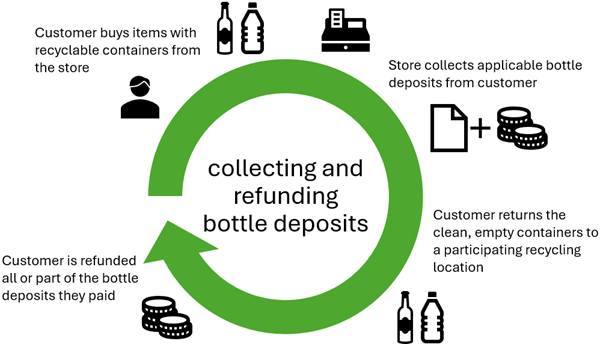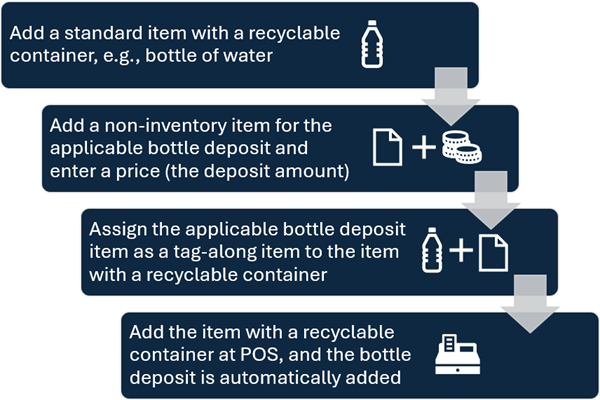Understanding bottle deposits
Today, many jurisdictions have container recycling programs to encourage consumers to recycle specific types of containers, such as aluminum cans, plastic bottles, milk boxes, drink boxes and drink pouches, gable top containers, and glass bottles.
In most container recycling programs, bottle deposits are collected from customers when they purchase items with recyclable containers. All or part of those deposits are refunded to customers when they return the clean, empty containers to a participating recycling location.

Some jurisdictions have a flat deposit amount for all eligible recyclable containers. Other jurisdictions have different deposit amounts for different types or sizes of containers. For example, a jurisdiction might have a $0.10 bottle deposit for aluminum cans and a $0.20 bottle deposit for large plastic or glass bottles.
Similarly, some jurisdictions require retail stores to accept clean, empty, eligible containers from customers and refund the relevant bottle deposits to them. In other jurisdictions this is optional. In jurisdictions where stores are required to accept eligible containers, it is common for stores to set daily limits on how many eligible containers each customer can bring to the store for bottle deposit refunds, e.g., a maximum of 24 cans per customer per day.
To charge customers a bottle deposit, you must create a non-inventory bottle deposit item and enter a price, such as $0.10. When there are different bottle deposit amounts (e.g., $0.10 for individual aluminum cans, $0.60 for six-packs of aluminum cans, $0.20 for large bottles) you must create separate non-inventory bottle deposit items with different prices.
The easiest way to charge bottle deposits is to assign the relevant bottle deposit item as a tag-along item. For example, for an individual can of soda, you would assign the $0.10 bottle deposit item as a tag-along item. For a six-pack of soda cans, you would assign the $0.60 bottle deposit item as a tag-along item. With this approach, when the cashier or salesperson adds an individual can of soda or a six-pack of soda cans to a transaction, the relevant bottle deposit item is automatically added as a tag-along item and the cashier or salesperson does not need to manually add the bottle deposit item.

If it is not feasible to assign the bottle deposit item as a tag-along item, you can define custom POS buttons or POS task pad buttons that cashiers or salespeople can use to quickly add bottle deposit items to transactions. The store would also need to train all cashiers and salespeople to consistently add the bottle deposit items to transactions whenever it is applicable. However, this can be risky, since it requires manual entry by cashiers and salespeople.
It is a best practice to assign a department and category to the non-inventory items used to collect bottle deposits. This makes it easier to exclude bottle deposits from store sales reports, or to create reports to track how much the store has collected or refunded in bottle deposits.